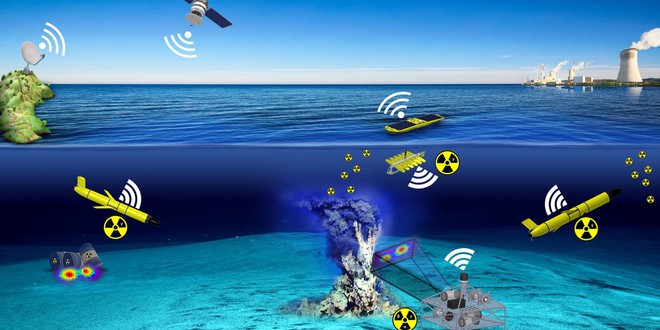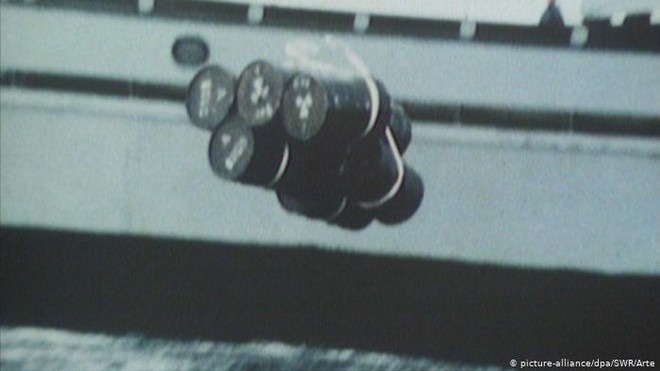Scientists are building a self-propelled submarine that “sniffs” radiation on the seabed, in order to detect earthquakes and tsunamis early
- Tram Ho
Recent volcanic eruptions took place in St. Vincent and Iceland did not cause direct human casualties, because they were both predicted by rice-operated tools: when people saw the great volcano erupt and the ground shook, they quickly reacted. out of the reach of the fatal event. However, vibrations located deep in the water, which can create tsunami waves hundreds of meters high, are difficult to detect. This is the main reason why they bring high mortality rate.
To remedy that, researchers at the University of Athens are developing an underwater drone capable of detecting radiation, which the team says will detect tsunamis caused by earthquakes early. undersea.
When seismic activity occurs on land, a radioactive gas called radon will crept into the ground many days before the official earthquake. Therefore, detecting radiation present in the seabed can help us predict the time of earthquakes.

However, like many other marine studies, we know very little about the ocean floor and how the factors that govern it work. To detect unusual radiation activity, science must first determine what is normal.
” The nature of radiation activity is still a mystery in oceanography, although its importance is still very great, ” said Professor Theo J. Mertzimekis of the University of Athens. He is currently leading a research team from the European Union to develop a submarine robot that can measure radiation activity on the seabed. The project is expected to last 4 years, and just kicked off this spring. They are currently developing sensors and artificial intelligence systems for this seabed drone.
Electronics have never been hydrophilic, and the pressure conditions at the bottom are unfriendly, not to mention groundwater currents that can make research difficult. The seismometer, the needle that draws squiggly lines on paper used to measure earthquakes, is less accurate in deep-sea environments, because vibrations from waves and high winds can distort measurements. . Professor Mertzimekis compared the difficulty of the seabed seismometer project to that of NASA’s Mars mission, considering the technological obstacles they faced.

Swimming into the deep sea is as difficult as flying high into the sky. Pictured is NASA’s Perseverance probe.
The drone project is called RAMONES, short for RadioActivity Monitoring in Ocean EcoSystems – Controlling Radiation Activity in Marine Ecosystems. The team does not want the drone to be able to be controlled remotely, but will try to make it fully autonomous. This will speed up the research several times and simplify the data collection process.
Currently, we do not have self-propelled vehicles on land, so the project of self-propelled submarines will be even more difficult to implement. The marine environment is complex, and the power source to operate artificial intelligence is limited, so the team wants to create an AI that can work with the lowest amount of energy possible. Besides, the sensor will also have to be compatible with the harsh life in the deep sea.
And yet, the researchers don’t just have seismic activity, but also want to know how human impact affects the radiation activity of the deep sea. During the 1950s and 1960s, nuclear bomb tests produced a by-product, a layer of the isotope cesium-137, and human drilling also produced radon gas. In addition, radioactive waste was discharged into the sea from 1946 until 1993, when countries joined hands to sign an agreement to stop toxic activities.
After four decades of dumping radioactive waste into the sea, we still don’t know what its consequences are. This will also be a question the RAMONES team seeks to answer.

Radioactive waste is thrown into the sea.
And just 3 weeks after the RAMONES project officially started, the Japanese government had to accept to dump radioactive waste into the sea after declaring it could not be treated. Japan’s nuclear power plant stood firm after the earthquake, but failed to withstand a hundred-meter-high tsunami. The action from Japan has also received many criticisms because we do not understand the impact of radioactive waste on the seabed ecosystem.
If the RAMONES project is successful, we will be able to answer many difficult questions at the same time, and at the same time have an earthquake/tsunami detection system early, to avoid the tragedy from happening again.
Source : Genk
